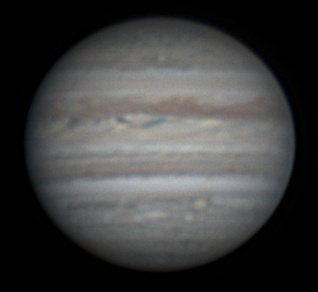

JUPITER' s Gallery
20180603
Jupiter 1 min (L) & 10 min (R) with Winjupos Derotation
Jupiter GRS, Io and Shadow
Animation (GIF)
Quality of seeing with wind ~ 9 Km/h
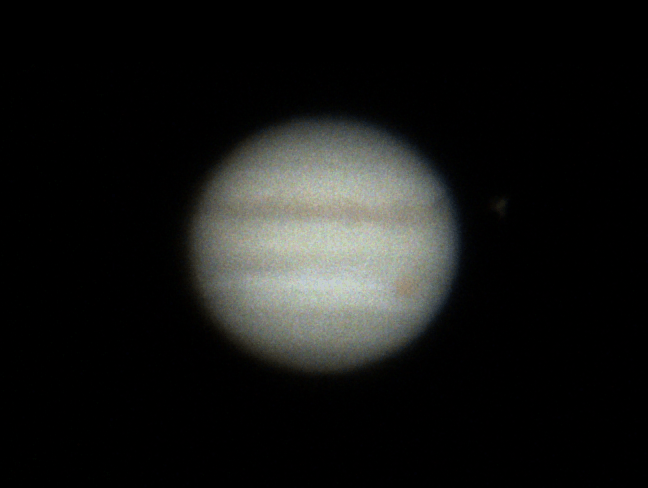
3D rendering
20180516 - Jupiter Rotation showing GRS
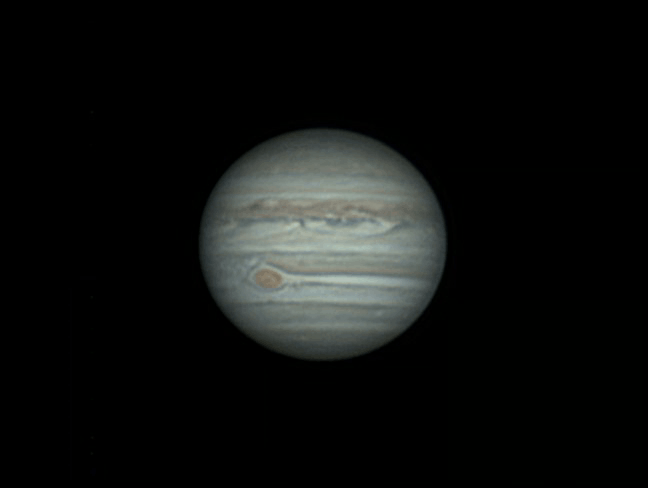
3D reconstitution ...
The ASI 224MC gives nice direct planetary results in colors ...
Telescope : LX200 10"
Acquisitions : 1 min
Processing AS3!, RegiStax6, VirtualDub (4 FPS)
20180515 - Jupiter GRS Rotation in 3D
Original very small sequence showing seeing :
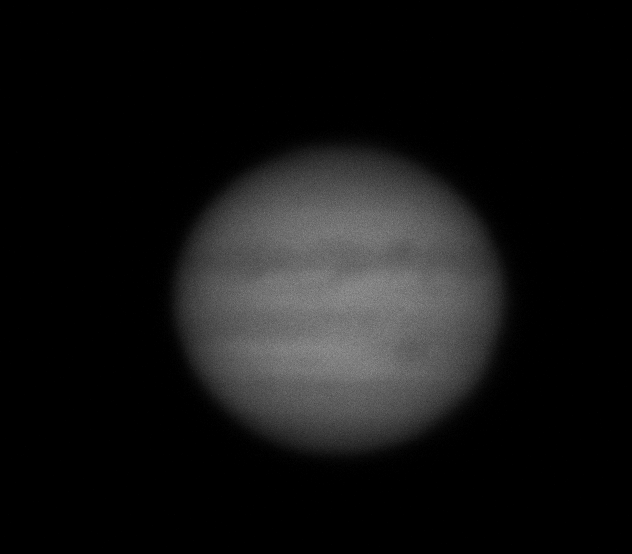
Of course I dont have a 3D telescope
but 3D can be simulated with smoothly translating bodies.
You can choose parallel 3D view (left 2 images) or crossed eyes view (right
2 images).
Click on image to enter 100% size, choose your 3D vision, lock it, and
move slowly down until the bottom image to see the rotation of the
GRS.
A color picture (from ASI224MC SER capture) at the end of the GRS transit is
also
added.
Barlow Televue 3X
Firecapture: 1 min 8b capture @ ~100 FPS / AS3:
NoiseR=6,
417x24p
AP
__
15%
of
FRM
Conv-60%Orig /
Registax6
Color image below captured in Bin 2xC
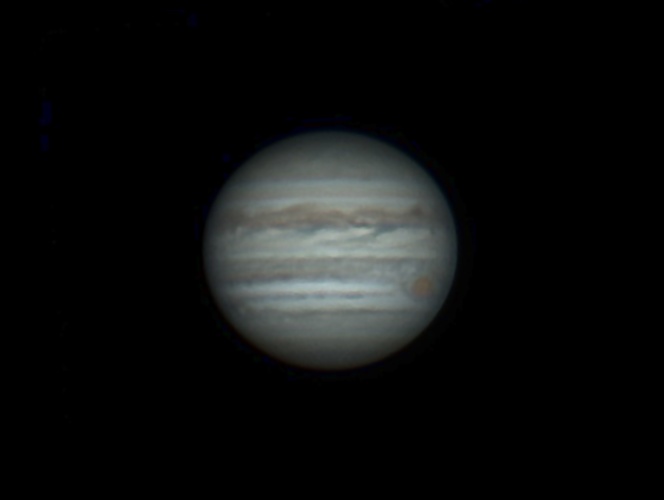
20170603... Large FOV
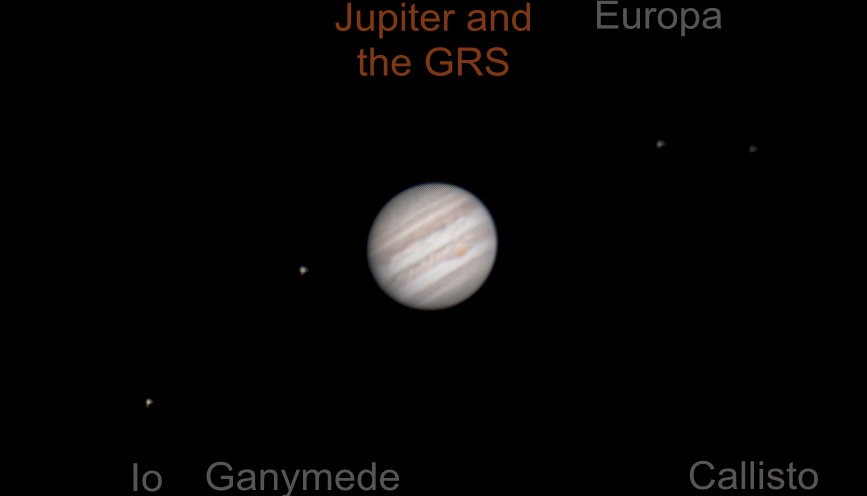
2017 opposition (occured on April 7)
20170517 ... 3D !
Jupiter with Meade 10 Classic, Powermate 2 4X barlow, ASI 224MC
color ZWO camera.
3D reconstruction with SPM (Stereophoto Maker) from 2 x 90s videos registered
with AS!3 (80% kept of 8060 frames, 4.8 GB each),
Wv enhanced with RegiStax6
and LRD in Astro Image3.
Time difference creating the pseudo stereoscopic effect
: 15 min (acquisitions at 19h45 & 20h00 UT).
3D presentation : crossed eyes (img 1) and parallel visions (img2).
20170510 ... First (automatic) WinJupos derotation trial !
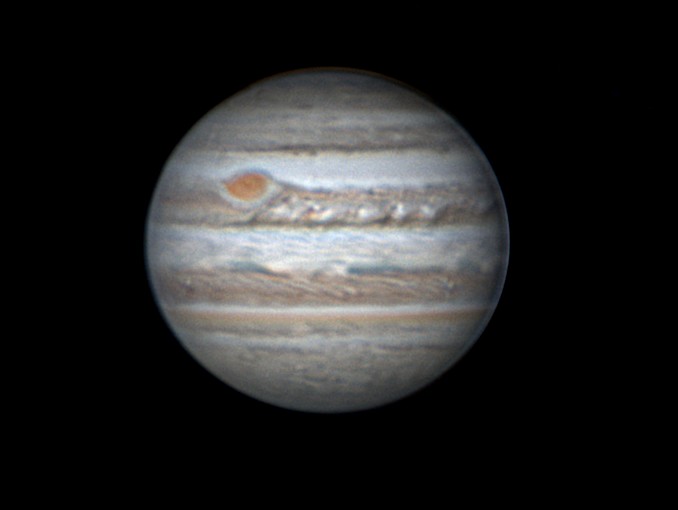
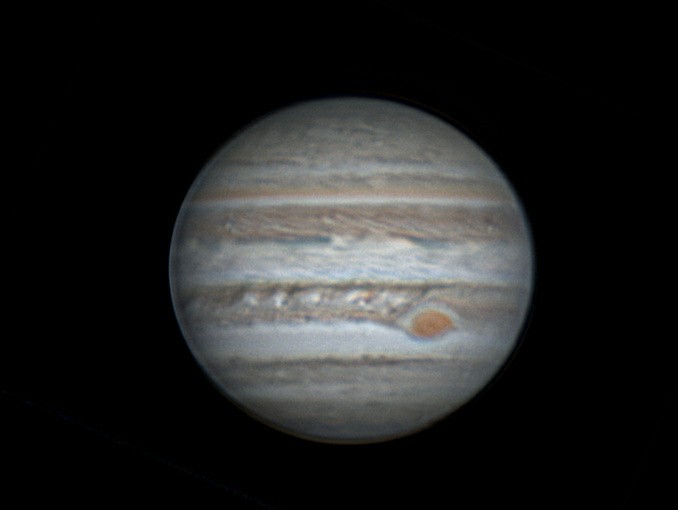
20170420 ... A great moment on Jupiter :
Complete Astromovie of the Transit of
Io and the GRS !
Note : wait until file is first loaded in memory then
it will run at 15 FPS !
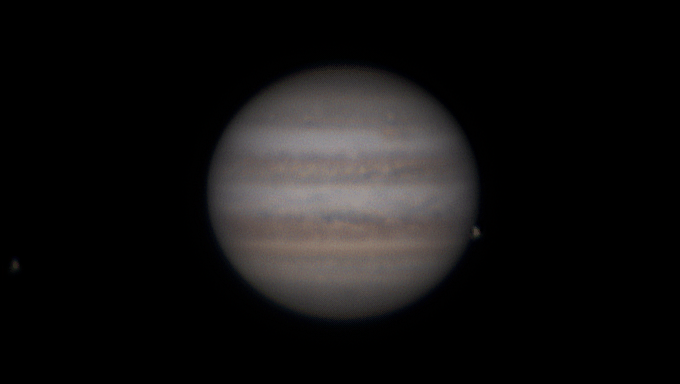
For
even better quality view or download
Lossless
(LAGS = Lagarith codec needed on your PC) (26 MB)
XVID (1.7 MB)
MOV
(350 kB)
This
animation spans on an exceptionally long time at least for me ...
About 5 hours for more than 100 GB of videos !
Technical data :
Location : Jerusalem, Israel (Lat +31° 43, Alt 800 m)
Date / Time : From 22h55 to 04h02 UTC+3
Weather : clear sky, good seeing (until Jupiter going to set !) in dry air.
Optics : Meade 10 Classic on tripod with equatorial mount + Antares 1.6x 2
Barlow (resulting FL 4000mm).
Camera : Color RGB, ZWO ASI 224MC
Jupiter :
Diameter=43.98
Magnitude=-2.45
Resolution=0.2
Europa visible at left on first image
Captures : FireCapture v2.5
Autorun session with 30s capture then 60 s wait, etc ...
Frames captured per movie : 2000 (kept for stack 90%)
File type=SER
ROI=680x390
FPS (avg.)=66
Shutter=15.00ms
Gain=241 (40%)
- Processing :
AS!3 (Autostakkert!3)
RegiStax5 (alignment with CG with 521x512 square), saving as registered movie
(LAGS)
VirtualDub (HSV adjust (saturation), rotate2, contrast 125%)
Gif conversion : PIPP
(Note : Published on spaceweather.com using the strongest lossy
compression and size reduction)
3D reconstruction
of two couples ...
The whole reconstruction would take a day of work ... not the time for
this now !
Presentation : 3D crossed - eyes ...
Bottom image : A couple of images extracted from the early transit
session (local
times
:
230043 & 231251)
before the shadow of Io appears on the disk of the planet because when this
happens
mounting in 3D shows the
shadow also in front, outside of Jupiter !
Top image : A couple of images extracted from the late transit
session (local times UT+3 : 004631 & 010138).
Here in 3D the shadow of
Io appears on the surface of Jupiter because it has been cloned at the same
place of Jupiter
surface
from one image to the other using the clone brush of StereoPhoto Maker
!
A large field of view showing the planet and 4 satellites

I used my Meade 10 Classic + 1.6x barlow and the camera was the
Sony A7s in Full Frame mode.
30 ARW (Sony RAWs) pictures (1/40s, ISO 2000) were taken in a row within a
few seconds.
They were converted to TIFF with Sony RAW converter.
Alignment
and
processing
was done in RegiStax6.
The picture have been enlightened with gamma but the 4 aligned satellites have
kept their relative brightness.
Only Jupiter using the R6 Gamma-Mask function
has not been modified.
The name of the satellites are visible in the accompanying image captured from
Stellarium ...
Note that Callisto (bottom left) is very dim and hard to see ! Dont
forget to click on 30% size image to have it full !
2012 opposition ...
Jupiter 3D with Europa.
Published by spaceweather.com
2012/12/30
LX200 12" F=15000 mm
Canon EOS 1100D in movie mode
Barlow Powermate 5x
Aligned RegiStax6 Stereo 3D with SPM
Selection of 3D vision mode, from top to bottom
: Parallel, Crossed
One is in cross-eyed vision, the other one
is in parallel vision. Jupiter is seen like a ball and Europa is within a couple
of minutes from being eclipsed behind the planet...
Images stack of about 1 min movies.
Temporal base ~8 min (00:04 & 00:12
UT)
Sometimes the sky is clear or almost but
there is a lot of wind. During this imaging session it was blowing at 65
Km/h !
I wanted to use the simplest setup as possible on my Meade 12 LX200.
I then used a Powermate 5x and a Canon EOS 1100D in movie mode.
Jupiter was
about 1/5 of the FOV then stayed visible even under the strong gusts of wind
...
The about 1 min long .MOV were converted to .AVI with NCH Prism and lightly
cropped in VirtualDub and save with lossless LAGS codec.
Registax6 was then
used for alignment, stacking and enhancement.
Two images of about 10 min spatial base were processed in SPM (Stereophoto
Maker) to make those 3D-couples.
Jupiter 3D with Io.
2012/12/17
LX200 12" F=7500mm
DBK 1/4" color camera
Barlow Powermate 2.5x
Aligned RegiStax6 Stereo 3D with SPM
Selection of 3D vision mode, from top to bottom
: Parallel, Crossed, Anaglyph
Upper 3D image stack of 500 frm mild processing, lower 3D image stack of 2000
frm
more intense processing
Jupiter is ~10 larger (diameter) than the
Earth and Io 3.5 smaller
Temporal base 10 min (21h40 & 21h50 UT)
.SER of 1 min à 60 fps in Y800 mono RAW
2012/12/05 23:08
LX200 12"
DBK 1/4" color camera
Barlow Powermate 4x
Aligned with Autostakkert2 & processed with RegiStax6 (other to follow)
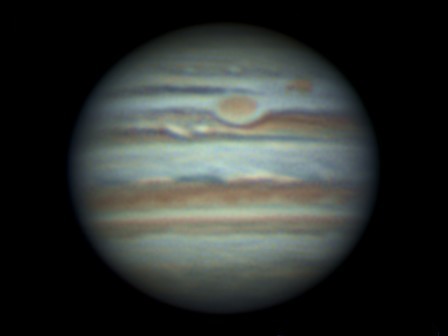
2012/11/09 01:23 and with IO emerging
03:20 UT
LX200 12"
DBK 1/4"
Barlow powermate 2.5x
1400 and 600 frames
Aligned with Autostakkert2 &
processed with RegiStax6
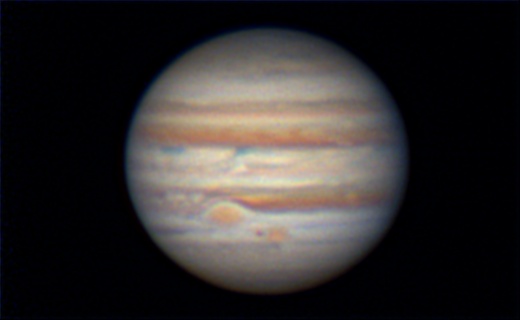
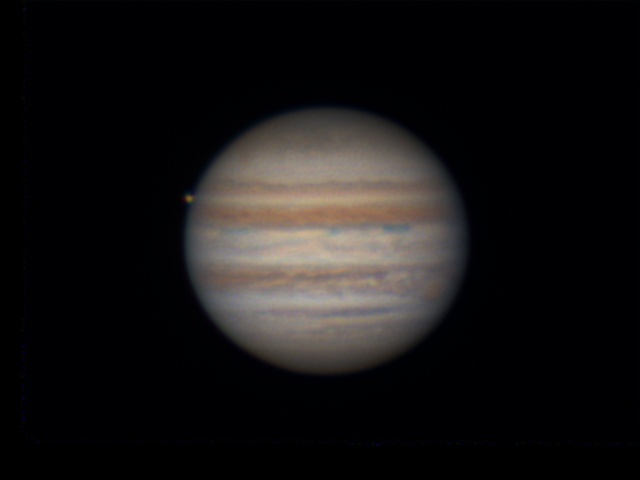
2011 opposition ...
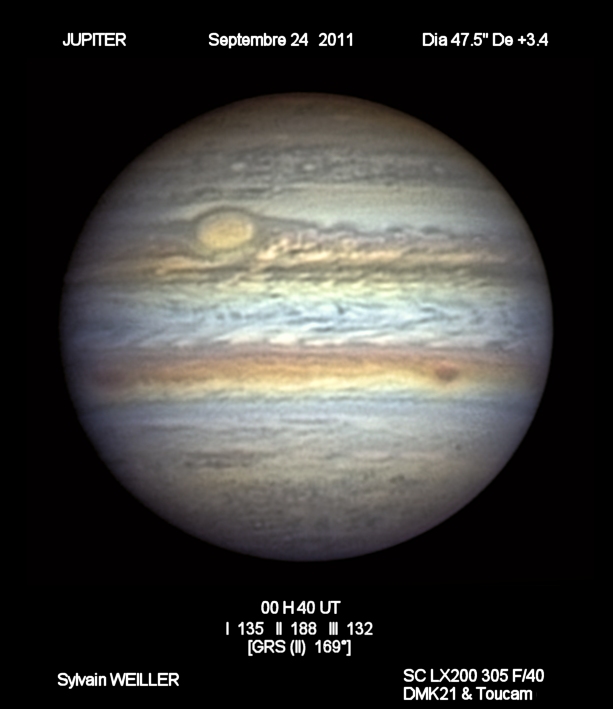
I had a rare night on Sep 24,
2011 ! The seeing was very good at my location ...
I decided to use two cameras to optimize the work in order to get an LRGB (or
here R-RGB) image
and to keep things more simple than usually when working with RGB filters.
As my main PC is on Win7x64, my Toucam is not recognized then I used 2 PCs with
huge hard disk space.
Settings :
LX200 12" GPS + 4x 2" Powermate + flip miror
Moded DMK 21AF04.AS (Firewire, B&W 618ALA 640x480 CCD sensor) + R25 filter
(@ 30 or 60 fps) on i7 950 (WIn7x64) PC
+
Firmware optimized Toucam Pro (USB1, color 640x480 CCD sensor) + IRcut filter
(@ 10 fps) on EEEPC (XP 32)
Both cameras on the flip miror
are manually aligned in rotation using 2 satellites of Jupiter visible in the
same FOV
and the border of the PCs screens as angle reference. Also they are both focused
on infinity.
To avoid any mistakes and as disk
space is not a problem, the captures are running all the time on both PCs then
I just have to change the flip miror position every minute without doing anything
on the PCs ... cool !
Then LRGB acquisition is about 2 (up to 3 if seeing not very good) min long.
The AVI are just limited to 20 000 frames for practical reasons ...
this means about 6 (B&W or color) captures per long movie ...
Each long movie contains alternative sequences of black signal (dark) and Jupiter
and is easily cut with VirtualDub into
individual sequence saved using HuffYUV multithread compatible RegiStax6 &
Win7x64.
Note : when you save one sequence, don't forget to update the date/time taking
into account the times from start shown at the bottom of VD !
More details on the structure of the recorded AVIs :
Legend :
S start, E end of movie,
=== sequence with visible Jupiter (B&W)
+++ sequence with visible Jupiter (color)
... empty sequence
1-6 number of the Jupiter sequences
One original N&B movie is
then like :
S===1...===2...===3...===4...===5...===6...E
One original color movie is like :
S...+++1...+++2...+++3...+++4...+++5...+++6...E
After cutting, processing will be with pairs of AVIs :
===1 & +++1 for the first LRGB image then ===2
& +++2 for the 2nd one, etc.
Processing is done as usual with RegiStax6 and eventually finished in Irfanview
(cropping...).
2010 opposition ...
Latest developments using a Canon with liveview and Registax batch mode :
The full visible rotation of the GRS has been capture at 22 fps during about 4h30. EOSMovrec saved 96Gb of compressed data (381 000 frames). Cut into 1000 frm (45sec) segments for Registax to batch process all !
More development is needed in Registax at the Batch level to be able to batch all the commands of the WV page. When this will be done, the 381 frame animation below will have instead of what I get actually, the quality of the middle still image without the artifacts !
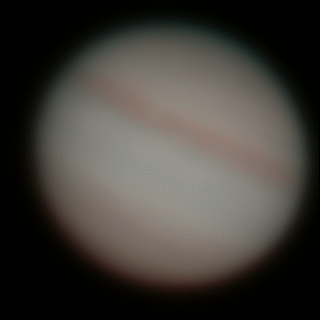
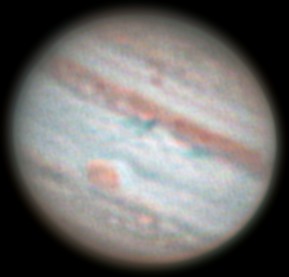

left animation of the stacked images and light enhancement in VirtualDub, middle nice manual processing one one AVi, right WV processing of animation.
2006
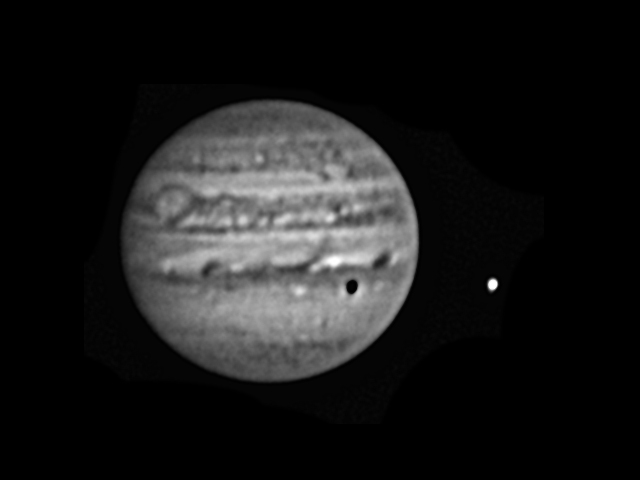
Above Jupiter and Io in grey tones, LX20012"
3x barlow-Toucam pro II B&W-R25 filter+IRcut-10fps
20060211_061412UT
Registax infos : ST1202_WSD_WVX_78_1000_10_10_10_CB60_20

3D view of Jupiter on the same night (left // vision
& right cross-eyed vision)
|
Sep 15, 2000 4h12 UT, T 6°C, good
seeing
SCT Black Celestron 8" on SP-DX mount, 3x Televue Barlow,
Philips Vesta Pro Webcam
186 images combined from a 62 sec Avi
You can see the shadow of Io near the GRS and Europe on the right
Jupiter satellites show a small disk
with a webcam and a Celestron 8" !
Jupiter & satellites,
Feb 1, 2001 193356-193456UT
2x apo Barlow Meade serie4000
ToUCam Pro in 640*480 mode
(low gain, high gamma, high luminosity)
Very good seeing
First the untreated combinaison of 277 original
frames,
Io is on the left and Ganymede on the right
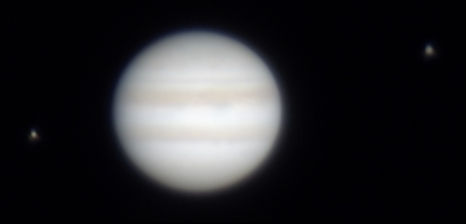
Now the combined image only modified about
gamma, contrast, luminosity & colors
You can see the sharpness on Jupiter
during this night of best seeing
(satellites, to dark are not visible anymore)
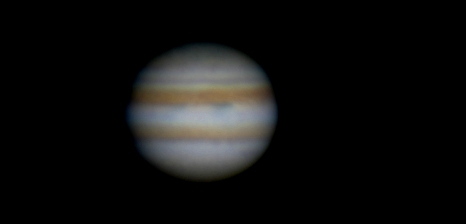
Here is a composition with Jupiter and
Io & Ganymede resized 400%
The only processing necessary to see all the details is a simple unsharp mask 2 300 in PSP6
|
|
|
IO (x4) |
JUPITER |
GANYMEDE (4x) |
You can download an untreated cropped movie of Ganymede
right
HERE
to make you own mind about thoses unbelievable results
!
(Zipped AVI of 58 Ko)
In order to know a little more if thoses satellites
"details" are only accentuated noise or not,
I suggest you study the following images :
On the left, 5 unprocessed pictures taken from
the original AVI,
at 100% original size (tiny balls) and 400% (big ones)
On the right, the same images after increasing
contrast and luminosity only
but without any inter pixel calculation
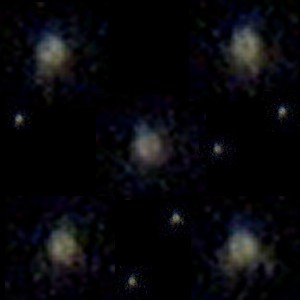
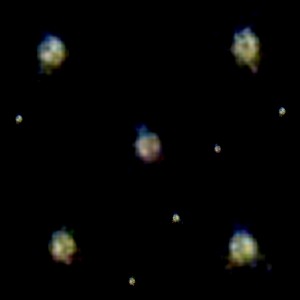
Of course the effect of the light turbulence is visible
but I think there is something
more than pure noise which appears even in the very tiny Ganymede dots
!
Voici maintenant un petit traitement pas du tout
alambiqué utilisé pour mettre
en évidence les "détails" à partir de 48 images brutes
redimmensionnées à 400%
sélectionnées pour la faible dispersion du disque de Ganymede
sur l'image,
donc de la plus faible turbulence obtenue ce soir là :
At last, the next images show the progression
of a very simple and classic processing
to make the "details" better seen. 48 raw images have been used,
selected for their low dispersion (lowest turbulence on that night) and resized
to 400%
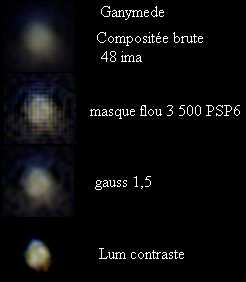
(As french text was put in the picture, the translation
is :
48 raw images combined / Unsharp masp 3 500 in PSP6 / Gauss 1.5 /
Luminosity-contrast)As
As you can see in
the lowest image, it is a little more red on the bottom and blue on the top.
This is corrected by realigning the color planes as done in the picture at
the top of the page.
That's it ! I can not analyse any further thoses
pionnier images.
Comments have been various & contradictory !
I hope more of them done by others and myself will lift up any doubt in the
future.
- - - - - - - - - - - - - - - - - - - - - - - - - - - - - - - - - -
- - - - - - - - - - - - - - - - - - - - - - - - - - - - - - - - - - - - -
- - - - -

SSep 4, 2000
SCT Black Celestron 8" on SP-DX mount, Philips Vesta Pro Webcam
You can see the four galileen satellites and two "H" stars behind,
Jupiter seems to control six satellites !
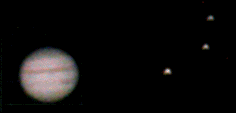
Satellites animation
Details later ...
Softwares used for processing :
Avi2bmp, http://avi2bmp.free.fr (Emmanuel Depigny),
AVIEDIT, http://milukov.webjump.com/ (Alexander Milukov).
& Paint Shop Pro 6
Texts and images of this web site all Copyright S. Weiller, 1999-2011
Permission granted to copy them only for non commercial use